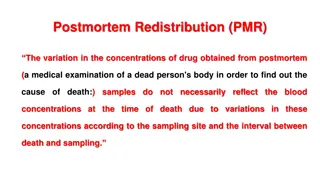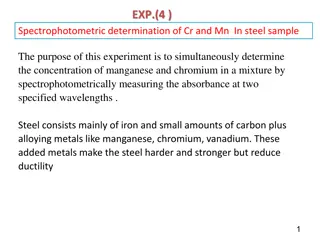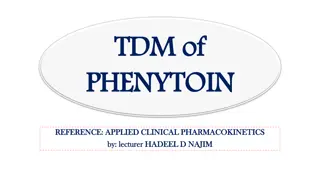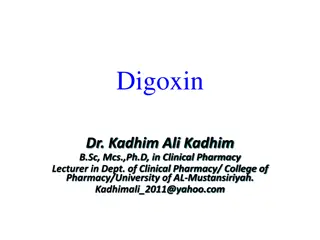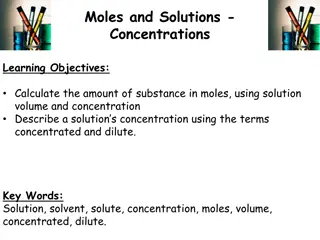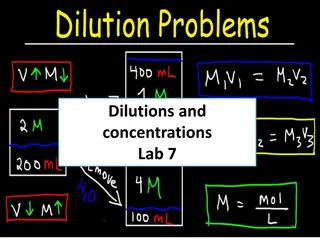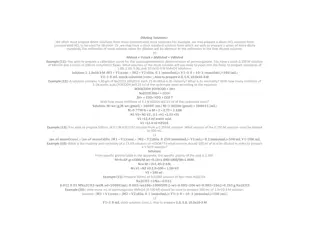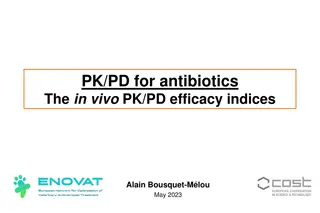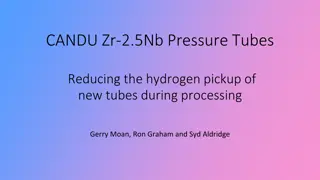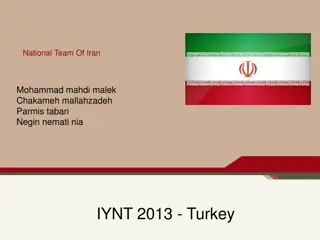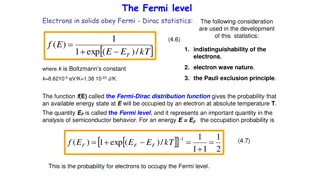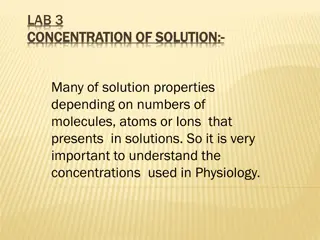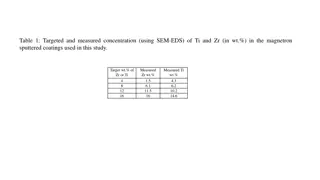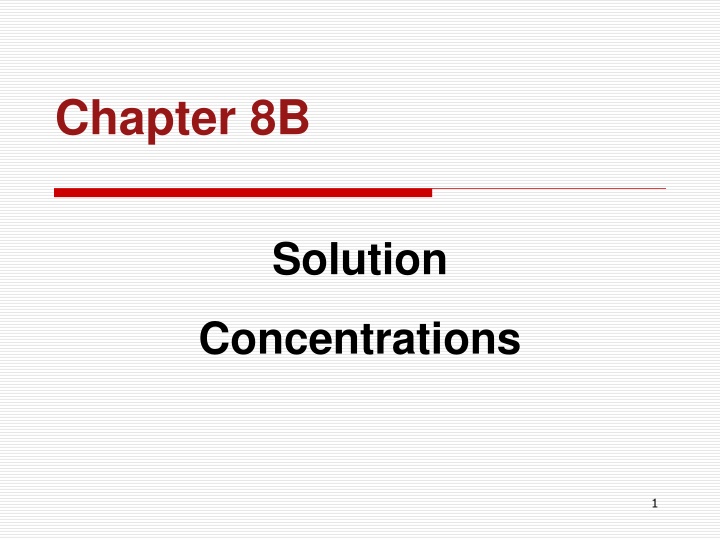
Solution Concentrations: Mass Percent, Molarity, and Dilution
Explore the concept of solution concentrations through mass percent and molarity, learn how to calculate concentrations, and understand the importance of dilution in creating solutions. Examples and explanations provided for better understanding.
Download Presentation

Please find below an Image/Link to download the presentation.
The content on the website is provided AS IS for your information and personal use only. It may not be sold, licensed, or shared on other websites without obtaining consent from the author. If you encounter any issues during the download, it is possible that the publisher has removed the file from their server.
You are allowed to download the files provided on this website for personal or commercial use, subject to the condition that they are used lawfully. All files are the property of their respective owners.
The content on the website is provided AS IS for your information and personal use only. It may not be sold, licensed, or shared on other websites without obtaining consent from the author.
E N D
Presentation Transcript
Chapter 8B Solution Concentrations 1
CHAPTER OUTLINE Concentration Units Mass Percent Using Percent Concentration Molarity Using Molarity Dilution Osmolarity Tonicity of Solutions 2
CONCENTRATION UNITS The amount of solute dissolved in a certain amount of solution is called concentration. amount of solute amount of solution Concentration = Three types of concentration units will be studied in this class: Mass Percent: (m/m) and (m/v) Molarity 3
MASS PERCENT Mass percent (% m/m) is defined as the mass of solute divided by the mass of solution. mass of solute mass of solution Mass % (m/m) = x100 mass of solute + mass of solvent 4
MASS/VOLUME PERCENT Mass/Volume percent (% m/v) is defined as the mass of solute divided by the volume of solution. mass of solute volume of solution Mass % (m/v) = x100 5
Example 1: What is the mass % (m/m) of a NaOH solution that is made by dissolving 30.0 g of NaOH in 120.0 g of water? Mass of solution = 30.0 g + 120.0 g = 150.0 g 30.0 g 150.0 g Mass % (m/m)= x100 = 20.0 % 6
Example 2: What is the mass % (m/v) of a solution prepared by dissolving 5.0 g of KI to give a final volume of 250 mL? 5.0 g 250 mL Mass % (m/v) = x100 = 2.0 % 7
USING PERCENT CONCENTRATION Some examples of percent compositions, their meanings, and possible conversion factors are shown in the table below: In the preparation of solutions, one often needs to calculate the amount of solute or solution. To achieve this, percent composition can be used as a conversion factor. 8
Example 1: A topical antibiotic solution is 1.0% (m/v) Clindamycin. How many grams of Clindamycin are in 65 mL of this solution? 1.0 g Clindamycin 100 mL solution 65 mL solution x = 0.65 g 9
Example 2: How many grams of KCl are in 225 g of an 8.00% (m/m) solution? 8.00 g KCl 100 g solution 225 g solution x = 18.0 g KCl 10
Example 3: How many grams of solute are needed to prepare 150 mL of a 40.0% (m/v) solution of LiNO3? 40.0 g LiNO3 100 mL solution 150 mL solution x = 60. g LiNO3 11
MOLARITY The most common unit of concentration used in the laboratory is molarity (M). Molarity is defined as: moles of solute Molarity = Liter of solution 12
Example 1: What is the molarity of a solution containing 1.4 mol of acetic acid in 250 mL of solution? 1 L 250 mL x = 0.25 L Vol. of solution = 1000 mL 1.4 mol acetic acid 0.25 L = 5.6 M Molarity = 13
Example 2: What is the molarity of a solution prepared by dissolving 60.0 g of NaOH in 0.250 L of solution? 1 mol 40.0 g 60.0 g x = 1.50 mol Mol of solute = 1.50 mol= 6.00 M 0.250 L Molarity = 14
Example 3: What is the molarity of a solution that contains 75 g of KNO3 in 350 mL of solution? 1 mol 75 g x101.1 g Mol of solute = = 0.74 mol 1 L Vol of solvent = 350 mL x = 0.35 L 1000 mL 0.74 mol 0.350 L Molarity = = 2.1 M 15
USING MOLARITY Molarity relationship can be used to calculate: moles solute Molarity = volume of solution Amount of solute: Moles solute = Molarity x volume Volume of solution: moles solute Molarity Volume of solution = 16
Example 1: How many moles of nitric acid are in 325 mL of 16 M HNO3 solution? 1 L 325 mL x = 0.325 L Vol. of solution = 1000 mL 16 mol L 1 mol of solute = = 5.2 mol 0.325 L x 17
Example 2: How many grams of KCl would you need to prepare 0.250 L of 2.00 M KCl solution? 2.00 mol L 1 mol of solute = = 0.500 mol 0.250 L x 74.6 g 0.500 mol x1 mol mass of solute = = 37.3 g 18
Example 3: How many grams of NaHCO3 are in 325 mL of 4.50 M solution of NaHCO3? 1 L Vol. of solution = 325 mL x = 0.325 L 1000 mL 4.50 mol L 1 mol of solute = = 1.46 mol 0.325 L x 84.0 g = 123 g 1.46 mol x1 mol mass of solute = 19
Example 4: What volume (L) of 1.5 M HCl solution contains 6.0 moles of HCl? L 1 1.5 Vol. of solution = = 4.0 L 6.0 mol x mol 20
Example 5: What volume (mL) of 2.0 M NaOH solution contains 20.0 g of NaOH? 1 mol mol of solute = 20.0 g x40.0 g = 0.500 mol L 1 2.0 Vol. In L = = 0.25 L 0.500 mol x mol 1000 mL 1 L Vol. In mL = = 250 mL 0.250 L x 21
Example 6: How many mL of a 0.300 M glucose (C6H12O6) IV solution is needed to deliver 10.0 g of glucose to the patient? 1 mol 10.0 g x180.1 g mol of solute = = 0.0555 mol L 1 0.300 Vol. In L = = 0.185 L 0.0555 mol x mol 1000 mL 1 L Vol. In mL = = 185 mL 0.185 L x 22
DILUTION Amount of solute remains Solutions are often prepared from more concentrated ones by adding water. This process is called dilution. increases Concentration decreases When more water is added to a solution, Volume constant Volume and concentration are inversely proportional Frozen juice Diluted juice Water 23
DILUTION The amount of solute depends on the concentration and the volume of the solution. Therefore, M1 x V1 = M2 x V2 Concentrated solution Dilute solution 24
Example 1: What is the molarity of the final solution when 75 mL of 6.0 M KCl solution is diluted to 150 mL? Volume increases Concentration decreases M1 x V1 = M2 x V2 M1 = 6.0 M V1 = 75 mL M2 = ??? V2 = 150 mL M V V (6.0 M)(75 mL) 150 mL M = 1 1 = 2 2 M2 = 3.0 M 25
Example 2: What volume (mL) of 0.20 M HCl solution can be prepared by diluting 50.0 mL of 1.0 M HCl? Concentration decreases Volume increases M1 x V1 = M2 x V2 M1 = 1.0 M V1 = 50.0 mL M2 = 0.20 M V2 = ??? M V M (1.0 M)(50.0 mL) 0.20 M V = 1 1 = 2 2 V2 = 250 mL 26
OSMOLARITY Many important properties of solutions depend on the number of particles formed in solution. electrolytes) dissolve in water they form several particles for each formula unit. For example: Recall that when ionic substances (strong Na+ (aq) + Cl (aq) NaCl (s) 1 formula unit 2 particles 27
OSMOLARITY Ca2+ (aq) + 2 Cl (aq) CaCl2 (s) 1 formula unit 3 particles 28
OSMOLARITY When covalent substances (non- or weak electrolytes) dissolve in water they form only one particle for each formula unit. For example: C12H22O11 (s) C12H22O11 (aq) 1 formula unit 1 particle 29
OSMOLARITY Osmolarity of a solution is its molarity multiplied by the number of particles formed in solution. Osmolarity = i x Molarity Number of particles in solution 30
Examples: 1 particle in 0.10 M NaCl = 2 x 0.10 M =0.20 osmol solution 0.10 M CaCl2 = 3 x 0.10 M =0.30 osmol 0.10 M C12H22O11 = 1 x 0.10 M = 0.10 osmol 2 particles in solution 3 particles in solution Same molarities but different osmolarities 31
TONICITY OF SOLUTIONS Because the cell membranes in biological systems are semipermeable, particles of solute in solutions can travel in and out of the membranes. This process is called osmosis. The direction of the flow of solutions in or out of the cell membranes is determined by the relative osmolarity of the cell and the solution. The comparison of osmolarity of a solution with those in body fluids determines the tonicity of a solution. 32
ISOTONIC SOLUTIONS Solutions with the same osmolarity as the cells (0.30) are called isotonic. These solutions are called physiological solutions and allow red blood cells to retain their normal volume. 33
HYPOTONIC SOLUTIONS Solutions with lower osmolarity than the cells are called hypotonic. In these solutions, water flows into a red blood cell, causing it to swell and burst (hemolysis). 34
HYPERTONIC SOLUTIONS Solutions with greater osmolarity than the cells are called hypertonic. In these solutions, water leaves the red blood cells causing it to shrink (crenation). 35
Examples: 0.10 M NaCl = 0.20 osmol hypotonic 0.10 M CaCl2 =0.30 osmol isotonic 0.10 M C12H22O11 =0.10 osmol hypotonic 36
THE END 37




